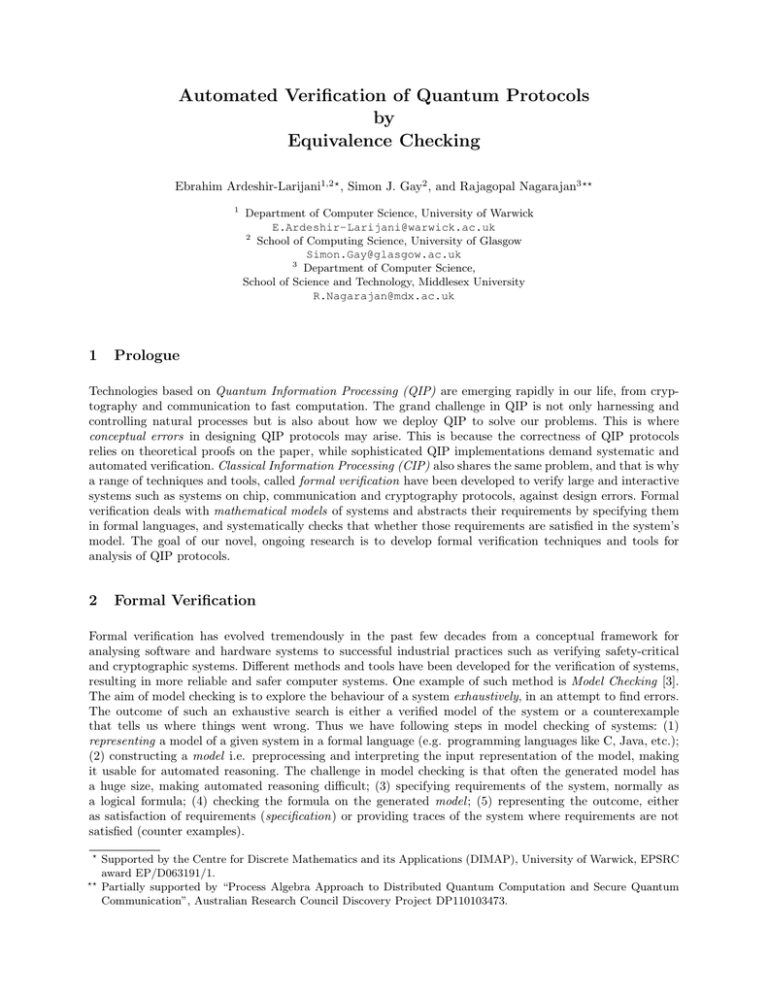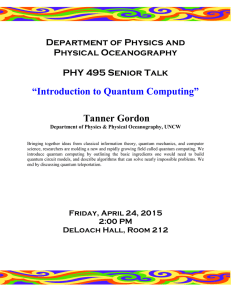Automated Verification of Quantum Protocols by Equivalence Checking Ebrahim Ardeshir-Larijani
advertisement

Automated Verification of Quantum Protocols by Equivalence Checking Ebrahim Ardeshir-Larijani1,2? , Simon J. Gay2 , and Rajagopal Nagarajan3?? 1 1 Department of Computer Science, University of Warwick E.Ardeshir-Larijani@warwick.ac.uk 2 School of Computing Science, University of Glasgow Simon.Gay@glasgow.ac.uk 3 Department of Computer Science, School of Science and Technology, Middlesex University R.Nagarajan@mdx.ac.uk Prologue Technologies based on Quantum Information Processing (QIP) are emerging rapidly in our life, from cryptography and communication to fast computation. The grand challenge in QIP is not only harnessing and controlling natural processes but is also about how we deploy QIP to solve our problems. This is where conceptual errors in designing QIP protocols may arise. This is because the correctness of QIP protocols relies on theoretical proofs on the paper, while sophisticated QIP implementations demand systematic and automated verification. Classical Information Processing (CIP) also shares the same problem, and that is why a range of techniques and tools, called formal verification have been developed to verify large and interactive systems such as systems on chip, communication and cryptography protocols, against design errors. Formal verification deals with mathematical models of systems and abstracts their requirements by specifying them in formal languages, and systematically checks that whether those requirements are satisfied in the system’s model. The goal of our novel, ongoing research is to develop formal verification techniques and tools for analysis of QIP protocols. 2 Formal Verification Formal verification has evolved tremendously in the past few decades from a conceptual framework for analysing software and hardware systems to successful industrial practices such as verifying safety-critical and cryptographic systems. Different methods and tools have been developed for the verification of systems, resulting in more reliable and safer computer systems. One example of such method is Model Checking [3]. The aim of model checking is to explore the behaviour of a system exhaustively, in an attempt to find errors. The outcome of such an exhaustive search is either a verified model of the system or a counterexample that tells us where things went wrong. Thus we have following steps in model checking of systems: (1) representing a model of a given system in a formal language (e.g. programming languages like C, Java, etc.); (2) constructing a model i.e. preprocessing and interpreting the input representation of the model, making it usable for automated reasoning. The challenge in model checking is that often the generated model has a huge size, making automated reasoning difficult; (3) specifying requirements of the system, normally as a logical formula; (4) checking the formula on the generated model ; (5) representing the outcome, either as satisfaction of requirements (specification) or providing traces of the system where requirements are not satisfied (counter examples). ? ?? Supported by the Centre for Discrete Mathematics and its Applications (DIMAP), University of Warwick, EPSRC award EP/D063191/1. Partially supported by “Process Algebra Approach to Distributed Quantum Computation and Secure Quantum Communication”, Australian Research Council Discovery Project DP110103473. 3 Equivalence Checking for Quantum Systems In [6] and [7] Gay, Nagarajan and Papanikolaou have developed a Quantum Model Checker (QMC) for checking models of quantum protocols such as Teleportation with stabilizer states as input. QMC verifies protocols within stabilizer formalism on given stabilizer states as input. Nevertheless, the results of QMC can be interpreted as an evidence for the correctness and not the proof of correctness of quantum protocols. In this work, however, we verify such protocols for arbitrary input states, using linearity of superoperators, in order to prove the correctness. We have implemented a variant of model checking, called equivalence checking. The aim here is to show two representations of protocols, one corresponding to the specification and another to the implementation, are equivalent, proving the implemented protocol satisfies the specification. The schematic process of equivalence checking is illustrated in Figure 1. Our tool Quantum Equivalence Checker (QEC) Equivalence Checker Model System Representation (Implementation) System Specification Checked Or Counterexample Fig. 1. Equivalence Checking follows the steps described in Figure 1, namely: to represent models, we have designed a language in which processes are defined separately, capable of communicating classical and quantum data. This is, of course, much more expressive than quantum circuit languages. Note that similar languages for analysing concurrent QIP systems have been developed, but they lack tool support (see [5], [10]). Our language is inspired by the influential work of Milner [8], in concurrency theory. The core idea of Milner’s formalism is that the behaviour of a concurrent system is understood based on what is observable from outside and how different processes interact with each other. Another reason for choosing this formalism is synchronised communication, given the lack of durable quantum memory. In this language, processes are formed using prefixes, “.”, and parallel composition “|”. The simplest process is nil, with no action. Also quantum operations are treated as prefixes. For example, Y (a).nil or X(a).nil | Z(b).nil, where X,Y and Z are Pauli operators, form instances of terms in this language. Sending and receiving a bit/qubit x over a channel c is done by c!x and c?x, respectively. As an example of using this language, Teleportation and its specification is illustrated in Figure 2. In contrast to quantum circuit diagrams, explicit communications between separate parties and parallel compositions can be expressed. This makes clear how parties interact with each other. A model is built by scheduling concurrent processes and simulating in the stabilizer formalism. For checking equivalence, we have defined a formal semantics of our model in terms of superoperators. This is inspired by the Quantum Programing Language in [9]. Now we want to check that implementation of a protocol behaves equivalently to its specification, e.g. Implementation ' Specification, that is to prove the two superoperators, corresponding to implementation and specification are equal. We check the equivalence of superoperators by using linearity, i.e. computing the effect of superoperators on the basis density operators and test the equality of final states. For testing equality of stabilizer states, we have designed an algorithm that checks the linear independence of stabilizer generators, partly using efficient algorithms in [2]. We have done a range of experiments on useful quantum protocols, ranging from Teleportation to Quantum Secret Sharing. We have used both sequential (models without parallel composition and communications) and concurrent models. In concurrent models, a sequence of actions are called interleaving, whereas in sequential models, they are known as branching. The experimental results are shown in the Figure 3. Implementation = //Preparing EPR pair and sending to Alice and Bob: newqubit y . newqubit z . H(y) . CNOT(y,z) . c!y . d!z . nil | //Alice’s process: input x . c?y . CNOT(x,y) . H(x) . m := measure x . n := measure y. b!m . b!n . nil | //Bob’s process : d?w . b?m . b?n . if n then X(w) . if m then Z(w) . output w . nil Specification = input x.output x.nil Fig. 2. Concurrent Teleportation and its Specification Protocol Teleportation Dense Coding Bit flip code Phase flip code Five qubit code X-Teleportation Z-Teleportation Remote CNOT Remote CNOT(A) Quantum Secret Sharing No. Interleaving CM 400 100 16 16 64 32 72 78400 23040 88480 343 120 62 63 500 63 78 12074 4882 13900 No. Branch SM 16 4 16 16 64 8 8 64 64 32 39 22 60 61 451 18 19 112 123 46 SEC 43 30 61 62 * 25 27 140 156 60 Fig. 3. Experimental results of equivalence checking of quantum protocols. The columns headed by CM and SM show the results of verification of concurrent and sequential models of protocols in our current tool. Column SEC shows verification times for sequential models in our previous tool [1]. The number of branches for SM and SEC models are the same. The model for (*) is not available due to the tediousness of implementation. Times are in milliseconds. 4 Conclusion We have presented an equivalence checking technique for automated verification of QIP protocols. We have used a more expressive language than circuit diagrams to specify concurrent QIP protocols and furthermore, we have implemented the tool QEC to carry out experimental results. Extending our technique beyond the stabilizer formalism and also developing more general notions of equivalence, such as bisimulation (similar to the approach of [4]), will be our future directions in this research. References 1. E. Ardeshir-Larijani, S. Gay, and R. Nagarajan. Equivalence checking of quantum protocols. In N. Piterman and S. Smolka, editors, Tools and Algorithms for the Construction and Analysis of Systems, volume 7795 of Lecture Notes in Computer Science, pages 478–492. Springer Berlin Heidelberg, 2013. 2. K. M. R. Audenaert and M. B. Plenio. Entanglement on mixed stabilizer states: normal forms and reduction procedures. New Journal of Physics, 7(1):170, 2005. 3. C. Baier and J.-P. Katoen. Principles of Model Checking. The MIT Press, 2008. 4. Y. Feng, Y. Deng, and M. Ying. Symbolic bisimulation for quantum processes. arXiv:1202.3484, 2012. 5. S. J. Gay and R. Nagarajan. Communicating Quantum Processes. In Proceedings of the 32nd ACM SIGPLANSIGACT Symposium on Principles of Programming languages, pages 145–157. ACM, 2005. 6. S. J. Gay, R. Nagarajan, and N. Papanikolaou. QMC: A model checker for quantum systems. In Proceedings of the 20th International Conference on Computer Aided Verification, volume 5123 of Lecture Notes in Computer Science, pages 543–547. Springer, 2008. 7. S. J. Gay, R. Nagarajan, and N. Papanikolaou. Specification and Verification of Quantum Protocols. In S. J. Gay and I. Mackie, editors, Semantic Techniques in Quantum Computation. Cambridge University Press, 2010. 8. R. Milner. Communication and concurrency. Prentice Hall, 1989. 9. P. Selinger. Towards a quantum programming language. Mathematical Structures in Computer Science, 14(4):527– 586, 2004. 10. M. Ying, Y. Feng, R. Duan, and Z. Ji. An algebra of quantum processes. ACM Trans. Comput. Logic, 10(3):19:1– 19:36, April 2009.






